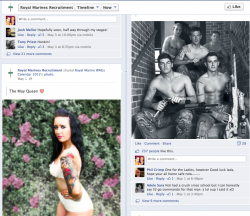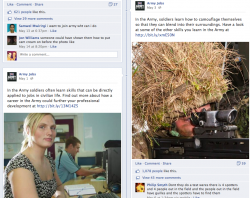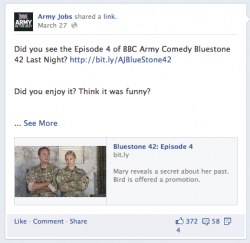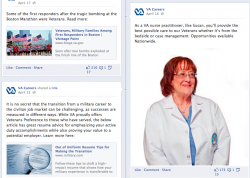 A recent analysis of who is winning the talent war in social media showed some surprising results. In particular, the strong showing of the military compared to large private sector companies. Who knew the public sector could beat Google at its own game?
A recent analysis of who is winning the talent war in social media showed some surprising results. In particular, the strong showing of the military compared to large private sector companies. Who knew the public sector could beat Google at its own game?
We’re used to mocking government departments for their slow uptake of technology and innovation, in everything from administration processes to marketing and communication. In the area of recruitment, however, some military organizations are mopping the floor when it comes to using social media to connect with potential recruits.
So … think you have a handle on social recruiting? Take a lesson from these military organizations.
Royal Marines
334,000 Likes, 690 Talking About
The Royal Marines (pictured above) is the poster child for successful engagement with potential recruits through Facebook. Is it because it posts pictures of scantily clad recruits?
Well, not only.
It also sets up its website for easy navigating and immediate connection to the information seekers are looking for. A phone number is listed in plain site on the “about us” section, and the four pages displayed prominently under the cover photo include the all-important “Apply” section.
What makes the Royal Marines page engaging is the variety of content. Videos and action shots are posted alongside shorter, text-based tips, and inspirational challenges. A full history of the organization complete with photos stretches back to 1664.
It’s a well-organized and media-rich site, which extends to its sister site The Royal Navy, another top performer with 71,000 likes.
U.S. Airforce
200,000 Likes, 9,000 Talking About
 With 150,000 less likes than the Royal Marines but with nearly 10 times as much engagement, the U.S. Air Force is the King when it comes to interactivity.
With 150,000 less likes than the Royal Marines but with nearly 10 times as much engagement, the U.S. Air Force is the King when it comes to interactivity.
Every post published requests some sort of interaction from the reader. At the very least, the phrase “Like this post to …” is used on every photo or video. Direct action requests like “Fill-in-the-Blank” posts encourage fans to interact weeks after the initial post in the form of hundreds of comments and thousands of likes.
Regular features also keep fans returning to the site. “Throwback Thursday” highlights an event in the past, such as the first woman to be selected for air combat training and successes in combat by particular fighter pilots
The page has become so good at responding to queries online, users have become accustomed to talking to the responder by name through the comments section, as if on a call with a customer service officer.
Clear information, engaging, shareable content, and high levels of interactivity. The U.S. Air Force has got the three essential ingredients for a successful Facebook campaign nailed.
British Army
290,000 Likes, 3,400 Talking About
 One of the reasons the Army manages to get higher engagement levels than the Royal Marines, despite more than 50,000 less fans, is its obsession with stories.
One of the reasons the Army manages to get higher engagement levels than the Royal Marines, despite more than 50,000 less fans, is its obsession with stories.
Guest chat sessions invite soldiers already in the army to discuss and answer questions directly with fans of the page. Even which soldier was chosen for the discussion was crowd-sourced through a voting panel.
There’s a strong link between the British Army’s Facebook page and its website. It regularly shares sections of its website, explaining its purpose and how that page can assist a seeker with more information.
 This connection with other platforms extends to online radio and YouTube by promoting and crowdsourcing ideas for episodes of “TA LIVE” as well as offline TV shows about the Army.
This connection with other platforms extends to online radio and YouTube by promoting and crowdsourcing ideas for episodes of “TA LIVE” as well as offline TV shows about the Army.
The wide variety of content as well as direct calls for interaction gives the ArmyJobs Facebook recruitment page its edge.
Veterans Affairs
88,000 Likes, 3,000 Talking About
Moving away from the military now but still within the same vein, Veterans Affairs scores the same level of interaction as the army with only an incredible third of the audience. Its interaction ratios even exceed the U.S. Air Force!
It has this level of success because its content aligns so strongly with its brand. As an organization caring for people, Veteran Affairs Careers focuses its message around its people and their values.
Every week, a quote or picture from a current employee is featured on the site, celebrating their contribution and enjoyment of the role. This personal engagement taps into the healthy pride of an individual and encourages shares within social circles. The recruitment page focuses as much on highlighting and celebrating its current community as recruiting more employees into it.
Positive values are shared in engaging poster-style formats, clearly displaying their logo and what that value means to the organization. These have generated high numbers of shared and comments — although not all of them are good!
 Another lesson in social recruiting from VA Careers is the way it responds to criticism. It can be tempting to remove negative comments from a public forum, but social media demands transparency. VA Careers provides answers in response to criticism numerous times through its Facebook page, demonstrating a desire to improve as well as attention to what people have to say — attractive qualities for potential recruits.
Another lesson in social recruiting from VA Careers is the way it responds to criticism. It can be tempting to remove negative comments from a public forum, but social media demands transparency. VA Careers provides answers in response to criticism numerous times through its Facebook page, demonstrating a desire to improve as well as attention to what people have to say — attractive qualities for potential recruits.
VA Careers is proof that even industries as potentially dry as service care can engage a loyal audience and community.
How does your organization stack up? It may be the first time you’ve heard an exhortation to learn from the government but I’m going to give it to you now — check out their recruiting pages for great ideas and inspiration on growing your own Facebook presence.